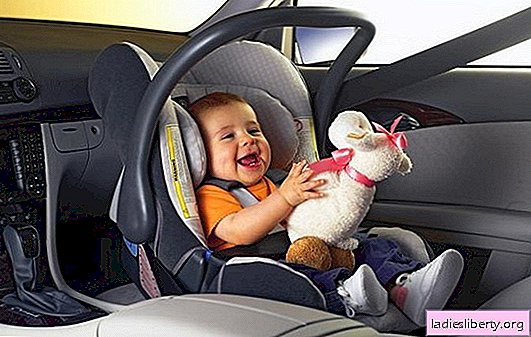
Riding a car with a child can be a serious test for the nervous system of parents, especially if you have a long trip.
After all, no matter how neat the driver is, and no matter how reliable the car is, for a fragile organism of a small child, the risk of injuries during movement is always high.
Therefore, the issue of transporting a child in a car should be taken with all seriousness and strictly follow all safety rules.
Can I transport my child in the front seat? What is the safest place in the car?
Some parents are confident that the child will be completely safe while driving in the car, only sitting on their lap, or being in a basket removed from the pram. However, many studies and tests performed suggest the opposite: a baby in a car should never be carried on an adult’s lap.
Another common misconception concerns the airbags installed on most modern cars. Therefore, to the question: "is it possible to transport a child in the front seat?" many parents answer in the affirmative, because their car is equipped with airbags. However, they forget that the design of these devices is designed for height and weight of an adult, and they can cause additional damage to a child in an accident.
In addition to safety rules, there are also rules of the road, according to which it is possible to transport a child in the front seat of the car only in a special restraint. This restriction applies to children under 12 years old. Therefore, non-compliance with these rules not only poses a threat to the life and health of the child, but also constitutes an administrative violation. The least traumatic place for a child in the car is a child car seat, installed in the middle of the rear seat.
How to transport a child in a car using a car seat
In most countries, installing a child car seat has long been the norm, as it is not only compliance with laws, but also the responsibility of parents. The choice of car seat should also be approached with all seriousness, since the health, and possibly the life of the child, will depend on it.
Car seat selection
First of all, you need to pay attention to the frame of the chair - it should be light and durable. The most reliable are car seats with an aluminum frame. Upholstery should be made of natural materials that absorb moisture and heat well. An additional advantage will be the availability of supports for arms and legs, so that the baby would be comfortable for a long time in the chair. You should also pay attention to the presence of a certificate that indicates the passage of special tests and tests.
Classification
Car restraints for children differ in design type and are selected according to the age and weight of the child. The most common form is car seats. Manufacturers divide them into the following groups:
• "Carriages" designed for the transport of newborns weighing up to 10 kg. Installed in the rear seat perpendicular to the movement of the car.
• "Cocoon Chairs" designed for children under 1.5 years old and weighing up to 13 kg. They have an anatomical shape and can be installed in both the front and rear seats.
• Car seats for children 1.5 to 4 years old. In these chairs the back position is regulated
• Car seats for children 3 to 7 years old. These devices are installed only in the direction of travel and fastened with a car seat belt.
• Car seats for children 6 to 12 years old. They can be used without a backrest as “booster cushions” that allow you to fasten your child with a regular seat belt.
In addition to car seats, there are other restraining devices:
• Transforming armchairs to transport children of different ages.
• Boosters raising the child to the required height
• Adapters that attach to the seatbelt and fit it to fasten the child.
Installation
The car seat must be securely fastened with seat belts. Allowed to move the chair to the sides no more than a few centimeters. The position of the chair is determined by the type of design, however, for newborn children, it is recommended to install across or back to the movement. The tilt of the chair also depends on the design, but the most optimal is a tilt of 45 degrees. Fasten the children so that the belt does not fall into the neck. Newborns are fastened below the shoulders, and children from 1 to 3 years old are slightly higher than the shoulders.
How to transport a child in a car: safety precautions
In addition to such a prerequisite for transporting a child in a car, such as installing a car seat, there are several unwritten rules that many parents forget about.
1. Before setting off, prepare your child for the upcoming trip. Be sure to introduce the baby to a car seat, as a new thing can cause him discomfort. An older child is instructed on how to behave in a car while driving. Also, before the trip, you can take the child with active games so that he does not get bored and does not distract the driver while driving.
2. Carry out a thorough inspection of all vehicle systems, make sure that it is fully operational. If possible, fix special curtains on the door to prevent direct sunlight from reaching the child.
3. Inspect the vehicle interior. There should be nothing superfluous, no dangerous objects. At the same time, you must take with you things that a child may need - water, food, wet wipes and medicines.
4. The driving style should be calm and uniform. Avoid overtaking, sharp turns and high speed.
5. If you have a long trip, plan it so that you can stop on the way every 2-3 hours.
6. Do not leave your child unattended while parked.
7. Do not feed the baby while moving.
8. Do not completely lower the door glass and do not allow the child to protrude from the window.











